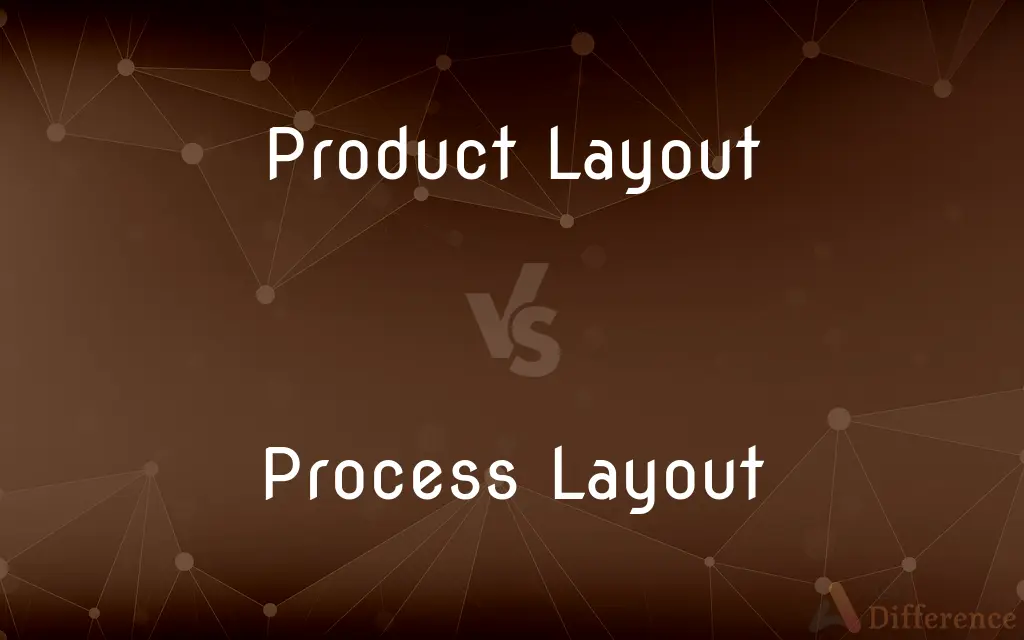Product Layout vs. Process Layout — What's the Difference?
Edited by Tayyaba Rehman — By Fiza Rafique — Published on December 18, 2023
Product Layout and Process Layout differ in design focus; Product Layout is designed around the end product, whereas Process Layout is based on production processes.

Difference Between Product Layout and Process Layout
Table of Contents
ADVERTISEMENT
Key Differences
In a Product Layout, the arrangement of the production process is set according to the sequence of operations required for the end product. This means that the machines and workstations are aligned in a linear fashion, optimizing the production flow for that specific product. On the other hand, a Process Layout arranges machinery and equipment based on the type of process they perform, grouping similar processes together.
Product Layout often resembles an assembly line. Here, products move through a set route, with each station equipped to perform a specific task. The primary advantage of this layout is its efficiency in mass-producing a single type of product. In contrast, Process Layout focuses on flexibility. Machines are grouped by function, so different products can be produced without rearranging machines.
Another distinguishing feature of Product Layout is its streamlined flow, which reduces movement and handling of parts, contributing to faster production times and reduced chances of errors. Meanwhile, a Process Layout might involve more handling and longer travel distances for parts, but it's more adaptable to changes in product design or when producing multiple products.
Within the realm of Product Layout, you typically find less flexibility. If there's a change in the product or a new product introduced, the entire layout might need to be restructured. Process Layout, on the other hand, can handle a variety of products without significant changes, making it more suited for industries with frequent product variations or customizations.
In summary, while Product Layout focuses on the efficient production of a specific product, resulting in a linear and streamlined workflow, Process Layout is built around the nature of the processes themselves, offering more flexibility and adaptability at the potential cost of efficiency.
ADVERTISEMENT
Comparison Chart
Design Focus
Centers around end product.
Based on production processes.
Arrangement
Linear alignment as per product sequence.
Machines grouped by function.
Flexibility
Less adaptable to product changes.
Highly flexible to different products.
Movement and Handling
Streamlined flow reduces movement.
Might involve more handling due to varied processes.
Ideal For
Mass-producing a single product.
Producing multiple or customized products.
Compare with Definitions
Product Layout
An organizational method focusing on the product's operational requirements.
Electronics manufacturers use Product Layout to ensure sequential component placement.
Process Layout
A layout where equipment arrangement changes based on the product's needs.
Craft breweries might utilize a Process Layout to brew different types of beer.
Product Layout
A layout where production processes are arranged based on a product's sequence.
Car assembly lines are often organized using a Product Layout.
Process Layout
A strategy prioritizing adaptability and diverse production capabilities.
A multi-product food processing plant implements a Process Layout for varied production lines.
Product Layout
A linear alignment of machinery optimized for specific product flow.
The soda bottling plant uses a Product Layout for efficient packaging.
Process Layout
An arrangement grouping similar processes together.
A bakery uses a Process Layout, with all ovens located in one section.
Product Layout
A design where each station performs a specific task in product creation.
In a toy factory, the Product Layout ensures each toy part is assembled in order.
Process Layout
A design that emphasizes flexibility in handling various products.
Custom furniture makers rely on Process Layout to manage different designs.
Product Layout
An arrangement emphasizing efficient production for a single product type.
Smartphone manufacturing units typically employ a Product Layout.
Process Layout
A layout organized around the type of process or function of machines.
In a metalworking shop, all drilling machines might be grouped together in a Process Layout.
Common Curiosities
How does Process Layout differ from Product Layout?
Process Layout arranges machinery based on the type of process they perform, grouping similar processes together, whereas Product Layout is designed around the end product.
Can a factory have both Product and Process Layouts?
Yes, a factory can incorporate elements of both layouts based on production needs and goals.
Is Product Layout more efficient?
Product Layout can be more efficient for mass-producing a specific product, but may lack flexibility for diverse products.
In which scenarios is Process Layout more suitable?
Process Layout is ideal for industries requiring flexibility, such as custom product manufacturing or where there are frequent product variations.
What is a Product Layout?
Product Layout is a design where production processes are aligned according to the sequence of operations required for a specific end product.
What's a typical example of Product Layout?
Car assembly lines often use Product Layouts.
Is Process Layout adaptable to market changes?
Yes, Process Layout is generally more adaptable to market changes due to its flexible design.
Where might I see Process Layout in action?
Custom furniture workshops often use Process Layouts to handle various designs.
Does Product Layout require more machinery?
Not necessarily. It depends on the product and production volume. The focus is on sequence, not the number of machines.
Are there any disadvantages to using a Process Layout?
Process Layout may involve more handling, longer travel distances for parts, and might not be as efficient as a Product Layout for specific products.
How does Product Layout affect workers?
Workers in a Product Layout typically have specialized tasks and follow a set sequence.
What industries typically use Product Layout?
Industries like electronics, automotive, and some packaged goods often use Product Layouts.
Share Your Discovery

Previous Comparison
Molecular Motion vs. Diffusion
Next Comparison
Addon Domain vs. SubdomainAuthor Spotlight
Written by
Fiza RafiqueFiza Rafique is a skilled content writer at AskDifference.com, where she meticulously refines and enhances written pieces. Drawing from her vast editorial expertise, Fiza ensures clarity, accuracy, and precision in every article. Passionate about language, she continually seeks to elevate the quality of content for readers worldwide.
Edited by
Tayyaba RehmanTayyaba Rehman is a distinguished writer, currently serving as a primary contributor to askdifference.com. As a researcher in semantics and etymology, Tayyaba's passion for the complexity of languages and their distinctions has found a perfect home on the platform. Tayyaba delves into the intricacies of language, distinguishing between commonly confused words and phrases, thereby providing clarity for readers worldwide.














































